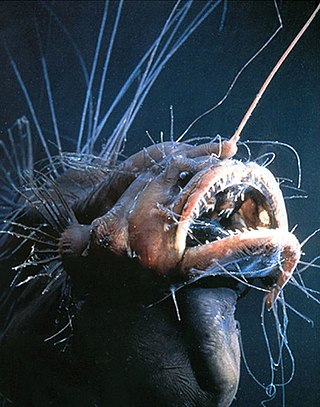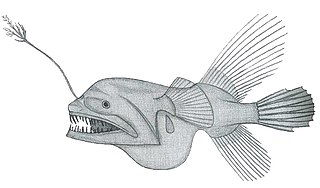
Ceratiidae, the warty sea devils, caruncled seadevils or seadevils, are a family of marine ray-finned fishes belonging to the suborder Ceratioidei, the deep-sea anglerfishes, in the anglerfish order Lophiiformes. The warty sea devils are sexually dimorphic with the small males being obligate sexual parasites of the much larger females. The fishes in this family are widely distributed from polar to tropical seas around the world.

Fanfins or hairy anglerfish are a family, Caulophrynidae, of marine ray-finned fishes within the order Lophiiformes, the anglerfishes. The fishes in this family are found almost around the world in the deeper, aphotic waters of the oceans.

Krøyer's deep sea angler fish, also known as the deep-sea angler, longray seadevil or northern seadevil, is a species of marine ray-finned fish belonging to the family Ceratiidae, the warty seadevils. It is found throughout the oceans of the world, from tropical to polar seas. It is the largest species in its family.

Oneirodidae, the dreamers are a family of marine ray-finned fishes belonging to the order Lophiiformes, the anglerfishes. These fishes are deepwater fishes found in the Atlantic, Indian and Pacific Oceans and it is the most diverse family of fishes in the bathypelagic zone.

The bulbous dreamer, or cosmoplitan dreamer, is a species of marine ray-finned fish belonging to the family Oneirodidae, the dreamers, a family of deep-sea anglerfishes. This fish has a circumglobal distribution in tropical and temperate oceans.

The toothed seadevil, spiny seadevil or netbeard seadevil,, is a rarely seen deep-sea anglerfish found in the mesopelagic and bathypelagic zones in Oceans around the World. It is the only species in the family Neoceratidae, and is unique amongst the deep-sea anglerfish in lacking an illicium and esca, and in having large teeth placed on the outside of its jaws.

Gigantactis is a genus of marine ray-finned fish belonging to the family Gigantactinidae, the whipnose anglers. The fishes in this genus have a circumglobal distribution in the deep waters of the tropical and temperate zones of the Atlantic, Indian and Pacific Oceans.

The whipnose anglers are a family, the Gigantactinidae, of marine ray-finned fishes which is classified within the suborder Ceratioidei, the deep sea anglerfishes. These fishes are found in the Atlantic, Indian and Pacific Oceans.
Rhynchactis leptonema is a species of marine ray-finned fish belonging to the family Gigantactinidae, the whipnose anglers. This species is known from widely scattered locations in the Atlantic and Pacific Oceans.

Himantolophus groenlandicus, the Atlantic footballfish or Atlantic football-fish, is a species of marine ray-finned fish belonging to the family Himantolophidae, the footballfishes. This fish is found primarily in mesopelagic depths of the ocean. Despite its name, this species might not be restricted to the Atlantic Ocean, with its range possibly extending into the Indian Ocean and to the Pacific Ocean. It is found in tropical and temperate regions.

Caulophryne polynema is a species of marine ray-finned fish belonging to the family Caulophrynidae, the fanfins. This species is a deepwater species which is found in the Atlantic and Pacific Oceans. Like other deepwater anglerfishes it shows extreme sexual dimorphism with the males being much smaller than the females and acting as sexual parasites of the females.

Caulophryne is a genus of marine ray-finned fishes belonging to the family Caulophrynidae, the fanfins or hairy anglerfishes. These fishes are found throughout the non-polar oceans of the world.

Ceratias is a genus of marine ray-finned fish belonging to the family Ceratiidae, the warty sea devils. This fishes in this genus are found throughpuit the world's oceans.

Caulophryne pelagica is a species of marine ray-finned fish belonging to the family Caulophrynidae, the fanfins. This species is a deepwater species which is found in the eastern Atlantic, Indian Ocean, Pacific Ocean and Southern Ocean. Its biology is little known but similar species show extreme sexual dimorphism with the very small makes seeking out and attaching themselves to the much larger females and becoming parasites of the females.

Caulophryne jordani, the fanfin angler, is a species of marine ray-finned fish belonging to the family Caulophrynidae, the fanfins. This species is a deepwater species which is found in Oceanic waters around the world. Like other deepwater anglerfishes it shows extreme sexual dimorphism with the males being much smaller than the females and acting as sexual parasites of the females.

Gigantactis paxtoni, Paxton's whipnose or slender anglerfish, is a species of is a species of marine ray-finned fish belonging to the family Gigantactinidae, the whipnose anglers. This species is found in the deeper waters of the southern Indo-Pacific.
Gigantactis meadi, Mead's whipnose, is a species of marine ray-finned fish belonging to the family Gigantactinidae, the whipnose anglers. This species is found in the deeper waters of the southern Atlantic, Indian and Pacific Oceans.
Gigantactis elsmani, Elsman's whipnose, is a species of marine ray-finned fish belonging to the family Gigantactinidae, the whipnose anglers. This species is found in the deeper waters of the Atlantic and Pacific Oceans.
Gigantactis kreffti is a species of marine ray-finned fish belonging to the family Gigantactinidae, the whipnose anglers. This species is found in the deeper waters of the South Atlantic and Western Pacific Oceans.

Linophryne lucifer is a species of marine ray-finned fish belonging to the family Linophrynidae, the leftvents, a group of deep water anglerfishes. This species is found in the North Atlantic Ocean. It is the type species of the genus Linophryne.















